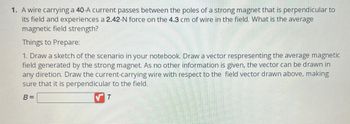Question

Transcribed Image Text:1. A wire carrying a 40-A current passes between the poles of a strong magnet that is perpendicular to
its field and experiences a 2.42-N force on the 4.3 cm of wire in the field. What is the average
magnetic field strength?
Things to Prepare:
1. Draw a sketch of the scenario in your notebook. Draw a vector respresenting the average magnetic
field generated by the strong magnet. As no other information is given, the vector can be drawn in
any diretion. Draw the current-carrying wire with respect to the field vector drawn above, making
sure that it is perpendicular to the field.
B=
T
Expert Solution
This question has been solved!
Explore an expertly crafted, step-by-step solution for a thorough understanding of key concepts.
Step by stepSolved in 2 steps with 1 images

Knowledge Booster
Similar questions
- 1. .A straight wire with length L carries a current I which is directed to the right and is perpendicular to an unknown uniform magnetic field B. A magnetic force F acts on a conductor which is directed downwards. A. Determine the magnitude and the direction of the magnetic field in the region through which the current passes. B. If the angle between the current and the magnetic field is e this time, what would be the new value of the magnitude of the new magnetic force? Pointing System for No. 1: • What are the given in the problem? • What are the unknown variables? • What are the equations that you are going to use? • Solution and answer for Part A. Solution and answer for Part B. L (cm) = 2306 | (A) = 13 F (pN) = 24 O = 61arrow_forwardYou have learned that a charge moving in an magnetic field can experience a magnetic force. Remarkably, anytime that a charged particle moves that particle produces its own magnetic field! The image below of magnetic compasses forming a circle around a current-carrying wire demonstrates the shape of the magnetic field. The magnetic field lines forms concentric circles around that wire. The strength of the field decreases with increasing distance away from the wire. If the current in the wire is 2.87A, what is the magnitude of the magnitude of the magnetic field (in μT, or micro-Tesla) a distance of 0.43m away from the wire?arrow_forward1. In the diagram below, a charged particle enters a region of uniform magnètic field where B 0.6 T. The particle has an initial speed of 2.7 x 106 m/s. Keep in mind Newton's Second Law and recall the equation for centripetal acceleration: 1²/r. a. Ignore gravity and first determine the sign of the charged particle if it follows the trajectory of the dashed semicircle. b. Next, use the information given to derive an equation for the charge-to-mass ratio (q/m) of the particle in terms of the particle's speed, the magnitude of the magnetic field and the radius of the semicircle. c. Lastly, calculate the charge to mass ratio of this particle. 95.0 cm Barrow_forward
- A hydroxide ion (OH−) in a glass of water has an average speed of about 600 m/s. A. Determine the magnitude of the electrical force between the hydroxide ion (charge -e) and a positive ion (charge +e) that is 1.0×10−8 m away (about the separation of 30 atoms). B. Determine the magnitude of the maximum magnetic force that Earth's 3.0×10−5 T magnetic field can exert on the ion.arrow_forwardA piece of wire carrying a current of 2.5 A is bent into a quarter circle arc of radius 15 cm as shown below. Determine the magnitude of the magnetic field at point P. O a. 8.33x10-7 T O b. 2.62x10-7T O. 5.24x10-7 T O d. 1.05x10-7-arrow_forwardA wire having a mass per unit length of 0.002 g/m carries an unknown current horizontally to the right. The wire is in a magnetic field of 0.10 T pointing into the page. a. Create a drawing and a free body diagram for this situation What current in the wire is needed in order for the wire to be in magnetic levitation?arrow_forward
arrow_back_ios
arrow_forward_ios